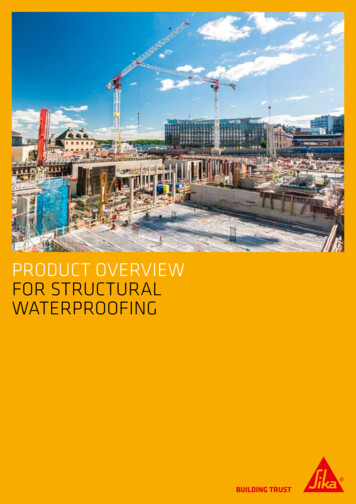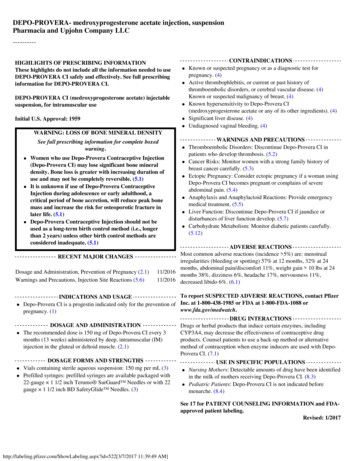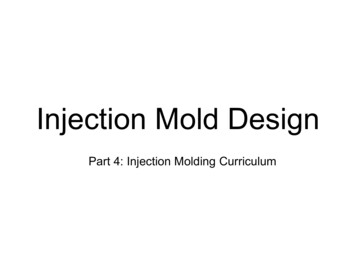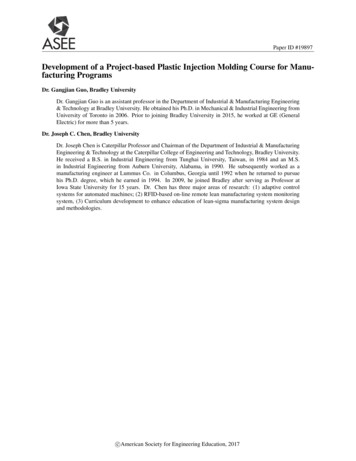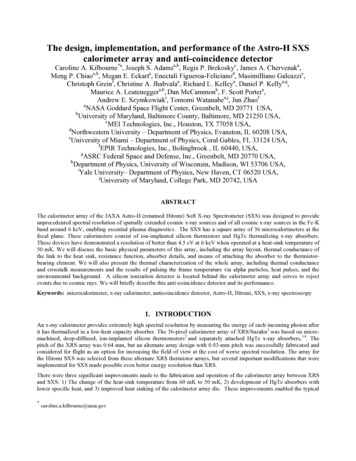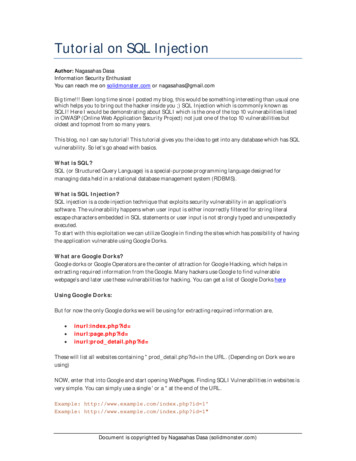
Transcription
Lattice Boltzmann modeling of injectionmoulding processJonas Latt1 , Guy Courbebaisse2 , Bastien Chopard1 , and Jean Luc Falcone11University of Geneva, Computer Science Department, 1211 Geneva 4, Switzerland,Bastien.Chopard@cui.unige.ch,WWW home page: http://cui.unige.ch/ chopard/home.html2LRPP - ERT 10 - ESP, 85 Rue Henri BecquerelF-01100 Bellignat, Francecourbebaisse@free.frAbstract. Polymer injection in moulds with complicated shapes is common in todays industrial problems. A challenge is to optimize the moulddesign which leads to the most homogeneous filling. Current commercial softwares are able to simulate the process only partially. This paperproposes a preliminary study of the capability of a two-fluid LatticeBoltzmann model to provide a simple and flexible approach which canbe easily parallelized, will include correct contact angles and simulatethe effect of the positioning of air-holes.Keywords: Polymer injection moulding, Hele-Shaw model, mathematicalmorphology, lattice Boltzmann method, multi-component fluids, numerical simulation.1IntroductionIn the injection moulding process, as in many other scientific problems, numericalsimulations play an important role. Polymer injection pressure, injection pointsand locations of air evacuation channels all affect the quality of the final object.In particular, the re-attachment of two fronts of matter (weld lines) leads tostrong internal constraints and weakens its mechanical resitance.Commercial softwares, such as MoldFlow, offer powerful tools to simulate themoulding process in the free surface approximation. They provide a quantitativedescription in which polymer properties can be adjusted. However, they offerlittle flexibility to combine the simulation with a shape optimization procedure.In addition, the free surface approximation does not allow the designer to studythe effect of the location of air evacuation points. Finally, parallelized versionsof such softwares are often not available.There is a need among the practitioners of this field to develop new approaches. In particular, there seems to be a lack of tools offering a pre-modelingof the injection process, with enough flexibility to investigate the impact of geometrical factors. There are several examples in which the mould geometry is
dominating in comparison with the fluid rheological properties. For instance,a recent original method based solely on the propagation of distances demonstrates that the injection process is more driven by the geometry of the mouldcavity than by the non-Newtonian features of the polymer. In other words, thecrucial hydrodynamic properties are mass conservation, forbidden regions andbehaviour at the mould boundaries.Along this line, the use of mathematical morphology concepts [1, 2] for thesimulation of the propagation of matter in a cavity, with one or more pointsof injection [3], is quite promising. The work by G. Aronsson [4] provides anexplicit link between the concept of propagation of distances and the spreadingof fluids with power-law stress tensors.The goal of this paper is to exploit the flexibility and simplicity of the LatticeBoltzmann (LB) method [5] to address the mould injection process at a premodel level. We consider the so-called Shan-Chen model [6] of two immisciblefluids representing the polymer and air respectively. We assume that Newtonianfluids will provide good approximations if geometrical factors are dominant. Inthis preliminary study we shall not pay too much attention to the actual ratioof densities and viscosities of the two fluids.We will first test our approach on the so-called Hele-Shaw situation (see forinstance [7]) and then consider a more realistic mould cavity. The LB resultsare compared with MoldFlow simulations. A discussion of the critical featuresof our approach is finally given.Note that, at the time of writing, we became aware of a similar work byGinzburg [8] in which a free-surface LB model is developed and applied to thefilling of a cavity. However, this model does not include air behaviour and doesnot take into account the effect of air evacuation points.2The lattice Boltzmann modelLattice Boltzmann (LB) models are historically derived from cellular automatafluid models [9, 5]. These models are seen as an alternative to finite elementtechniques for fluid flow computations. They have been successfully applied tomulti-phase and multi-component flows and several other applications. In thepresent context, we propose to adapt the LB methods to the filling phase of aninjection moulding process.2.1The lattice Boltzmann equation for a single fluidA LB model is built on a discrete space-time universe. The fluid is describedby density distributions function fk (x, t), k 0 . . . z containing the amount offluid that enters lattice node x at time t, with velocity v k , k 0 . . . z. Thepossible velocities are constrained by the lattice topology. Typically, z is thelattice coordination number and the discrete set of velocities is chosen so that,in one time step t, the particles travel one lattice spacing x in any of the z
lattice directions. One also considers a rest population of fluid particles f0 , withvelocity v 0 0.The usual physical quantities such as local density and velocity are obtainedfrom the fk by the following relations:ρ zXfkandu k 0zXfk v k .(1)k 0During time evolution, the fluid density functions are streamed on the lattice,in the direction specified by k. After the streaming, a collision occurs between allthe fk entering the same lattice site. The result of this collision is to redistributemass and momentum to each lattice directions, thus creating the post collisionvalues of the fk . It can be shown that, provided that the collision operator isproperly chosen, the LB dynamics solves the Navier-Stokes equation [9, 5], in thelow Mach number regime.It is also shown that the fluid pressure is related to the fluid density by theideal gas state equation p c2s ρ, where c2s is the speed of sound. Therefore, ina LB model, there is no need to solve the pressure equation. It is all built-in inthe equation of motion for the fk .In what follows, we consider a two-dimensional system, with z 8. Thiscorresponds to the so-called D2Q9 model [5]. The collision is obtained by arelaxation with coefficient ω to a truncated Maxwell-Boltzmann local equilibriumdistribution function f (eq) , which depends only on the current local fluid densityρ and velocity u. This approach is referred to as a LBGK model [9, 5].The following equation summarizes the evolution rule: (eq) γF int · v i(2)fi (x v i t, t t) fi (x, t) ω fi fiwhere Fint is a term which may account for extra interaction force acting onthe particle density distribution. The coefficient γ is a normalization parameterwhich depends on the chosen lattice topology.In order to model a system of two immiscible fluids (polymer and air) weuse the so-called Shan-Chen model [6]. Two sets of fk are defined, one for eachspecies. The values corresponding to the two fluids will be distinguished by asupperscript σ 0, 1. Each fluid follows the dynamics of a single fluid system,as given in eq 2. There are only two changes that must be made to describe theinteraction between the fluids.First, the fluids define a common velocity and use it for the computation ofthe equilibrium distribution in equation 2Pσσ,i fi v i(0)(1)u u u P(3)σ .σ,i fiSecond, the term Fint is computed so as to produce a repulsive interactionforce between the two fluids. It depends on a parameter W that accounts for thesurface tension of the fluids:X(σ)F int (x, t) W ρ(σ)Ψ (σ) (x τ v k ) v k .(4)k
In the bulk of the fluid, the quantity Ψ corresponds to the density of the otherfluid:Ψ (σ) ρ(1 σ) .(5)When one models immiscible fluids, one chooses an interaction force that issufficiently strong to keep the penetration between the fluids low. The simulatedflow field is thus separated in two regions, in each of which one fluid is dominant.In a small range around the interface between those two regions, both fluidscoexist symmetrically. In this range, the density variations are large and theapproximation for an incompressible fluid is not valid any more. The resultsmust rather be understood as representative of some kind of interface dynamicsbetween the immiscible fluids.3Boundary conditionsOn the boundaries of the domain, a specific dynamics is applied on the fluiddensity distributions fiσ in order to produce the desired effect: no-slip on a wall,fixed air pressure on the air-holes and specific contact angle at the interfacebetween air, polymer and solid walls. Finally, polymer injection points also needa special treatment. The boundary conditions we propose are discussed below.3.1Bounce back boundariesWe implement no-slip boundaries (i.e. boundaries on which the velocity is zero)by assigning bounce back dynamics to the boundary nodes. Thus, the dynamics (2) is replaced by a reflection rule:(σ)(σ)fi (x, t t) foppositeOf (i) (x, t).(6)The index oppositeOf (i) is the index associated with the direction opposite todirection i: voppositeOf (i) vi .The flow sites next to the boundaries interact with the boundary sites througha wetting parameter g (σ) . The value of Ψ from equation 4 is thus defined on theboundary nodes byΨ (σ) g (σ)(7)The value of g (σ) determines the contact angle of the fluid interface on thewall [10]. In our simulations, we have chosen g (σ) g (1 σ) . The situation isexplained on Figure 1. On this figure, fluid 1 is wetting, and fluid 0 is non-wetting.This effect is obtained by chosing g (0) 0 and g (1) 0.3.2Inlet and outlet boundaries.As a boundary condition for the injection spot and the air-holes, we define semipermeable walls: one fluid is retained by a normal no-slip condition, while theother fluid is injected or evacuated.
Fig. 1. Bounce back boundaries with a defined contact angle.Fluid 0Fluid 1(0)(1)F wallF wallθLet us consider as an example the case of fluid 0 being evacuated through thesemipermeable wall. We chose to perform the evacuation at a constant pressure.This is achieved by applying on fluid 0 the (constant pressure) outlet boundarycondition described in the reference [11]. Furthermore, an interaction term Ψ (1) ρ(0) is defined on the wall. This means that fluid 1 acts like a bulk node (5),rather than a wall node (6).For fluid 1 we implement a (no-slip) bounce-back dynamics on the wall.Consistently with the presence of this semi-permeable wall, a wetting parameterΨ (0) g (0) is defined.4Simulation of an injection in free spaceA first validation of the numerical model is obtained from a simple simulationwith cylindrical symmetry. A polymer is injected at a spot in free space andexpands in the form of a disk of increasing radius R. This is the well knownHele-Shaw model [7]. In this case, the boundary conditions have a subsidiaryimportance. We can therefore verify whether the basic properties of the polymerare properly resolved by the model.4.1Assumptions about material propertiesIn the particular case of injection moulding, we consider only very high viscousfluids. In consequence, the inertial and gravitational terms will not be taken intoaccount in the momentum equation. This simplification leads to a well knownequation : the Stokes equation (see for instance [7]). During the filling phase, thepolymer is assumed to be incompressible. The resulting equations are : .v 0(8) p .σ n 0(9)where v is the fluid velocity, p the pressure and σ n the viscous strain tensor.
4.2Hele-Shaw assumptionsThe Hele-Shaw model describes the filling of a mould cavity whose thickness canbe neglected. The filling fluid flow is modelled according to the Stokes equationbetween two plates separated by a short distance h.We consider a cartesian coordinate system where the z-axis is in the thicknessdirection. The x y plane is on the mid plane of the cavity and the velocitycomponents ux ,uy and uz are respectively taken in the x, y and z directions.The Hele-Shaw flow model consists of the following assumptions [12]:– The z-component of the velocity is neglected with respect to the other velocity components.– The pressure is constant across the thickness. It only depends on x and y.– The velocity gradient in the x and y directions is independent of the zdirection.Applying the Hele-Shaw assumptions to the Stokes equation, one obtains thesimplified expressions: ux p uy p pη,η, 0(10) x z z y z z zwith η the viscosity.These equations can be solved explicitly in the case of a disk mould with aconstant injection rate Q [7].Inside the injected polymer, the distribution of the pressure is predicted asfollows:p(r) a b ln r(11)where r R is the distance to the injection point and a and b are constant. Thedistribution of the velocity is given byρ(r)v(r) Q2πr(12)Finally, the expression for the surface growth of the polymer follows directlyfrom the mass conservation in an incompressible fluid:πR2 Qt4.3(13)Numerical resultThe geometry of the simulation is a square domain of size 201 201, initiallyfilled with air (fluid 1) at a density (pressure) of 1.0. At the boundary of thedomain, the pressure of fluid 1 is kept constant at this value.Fluid 1 (the polymer) is injected in the middle of the system, on one latticesite, with fixed density (pressure) ρ1 1.1. The two fluids have same viscosity(relaxation coeficient ω 1) and their mutual interaction is defined throughW 0.3.
t 4000t 40000t 80000t 140000Fig. 2. Amount of polymer injected as a function of time, in a free space. In the laterstage, the anisotropy is due to the air which cannot escape fast enough out of theboundaries.The evolution of the system is represented at four chosen time steps in Figure 2. We expect from equation 13 that the radius of the injected disk increasesas a square root of the time. This fact is verified on the simulations, both fromthe program MoldFlow and from the lattice Boltzmann model (see Figure 3).We have measured the velocity and pressure profile in the simulation at thetime step t 140000. The results inside a radius of r 30 are shown in Figure 4.They exclude the domain close to the free boundary that obeys special interfacedynamics. Note that the velocity v is the modulus of the velocity (ux , uy ).In agreement with the predictions of the Hele Shaw theory (equations 11and 12), the datapoints are fitted with a logarithmic law for the density and anr 1 law for the velocity. The value of Q used to fit the data is the one that ismeasured in the simulation: our injection boundary condition at a given pressure(density), fills the mould with a constant flow Q.The above results show that Hele-Shaw model is correctly obeyed by the LBsimulation.55.1Simulation of a realistic moulding problemOverviewAs a second sample application, we consider the moulding of a charge card withintegrated chip. In this case, the space taken by the chip is excluded from themoulding domain.The aim of this application is to show that even somewhat complex geometries can be addressed with the simulations. In general, the implementation of appropriate boundary conditions is a very delicate topic. However, fairly appealingresults are obtained already with the simple boundaries we have implemented.5.2ResultsIn the simulation, the surface of the charge card is initially filled with air (at adensity ρ0 1.0). The polymer is injected on the side opposite to the chip, at alevel corresponding to the middle of the chip location.
25radius of the injected ig. 3. Evolution of the disk radius during an injection in free space. On the left handside (a), the results from the program MoldFlow are presented, on the right hand side(b) the results from a lattice Boltzmann simulation. On the upper part of the pictures,the surface of the injected polymer is plotted at successive timesteps. On the lowerpart, the curves for the time evolution of the radius are fitted with the predictions ofthe Hele-Shaw theory.Velocity plot 39x 10Pressure 20distance (r) to injection253005101520distance (r) to injection2530(b)Fig. 4. Velocity profile (a) and pressure profile (b) at t 140000 obtained from thelattice Boltzmann simulation. The solid line shows a fit with the predictions of the HeleShaw theory.
The injection is made at a density ρin 1.01. The air is evacuated on theright boundary of the card at a constant density ρout 1.0. All other boundariesimplement a bounce-back condition with g (0) g (1) 0, which produces acontact angle of π/2. The surface tension is chosen at a value W 0.3.Figure 5 plots the area occupied by the polymer at successive timesteps, firstcalculated by the commercial program MoldFlow and, secondly, calculated bythe LB method. The difference betweend (b) and (c) consists in the way theboundary conditions are defined on the chip perimeter (see caption). The resultsof both simulations are very similar in the beginning. In the second part of thesimulation, the LB method turns out to be more sensitive to the geometry ofthe domain than the MoldFlow simulation.(a)(b)(c)Fig. 5. Mould of a charge card. The curves show the propagation front of the polymeras computed from the program MoldFlow (a) and the lattice Boltzmann method (b,c).In (b), a bounce-back condition is applied on the surface of the chip, whereas in (c),the air is evacuated at constant density on the chip perimeter.The sensitivity of the flow dynamics to the geometry of the domain that weobserve in the LB simulation is due to the pressure of the air on the polymer.Indeed, one of the main advantages of the LB method, the ability to model theinfluence of the air on the dynamics, also introduces some complications. If, asin our simulations, the air is not evacuated fast enough, this can have a seriousimpact of the flow dynamics; the resulting flow geometry may disagree with realmoulding applications, where the air is much lighter and less visous than thepolymer. In this context, some work still needs to be done either on the flowproperties of the air or on the boundary conditions.
6ConclusionThe LB methods brings several interesting elements in the process of injectionmodeling. The possibility to consider the full system of two fluids (air plus polymers) and to include air traps makes it possible to model how air escapes fromthe mould as the polymer expands. This feature is not offered by current softwares. In this respect, our preliminary results are relevant. They are especiallyencouraging in the case of the charge card with a complex geometrical shape.One assumption of our preliminary study was that both fluids have the sameviscosity and density. The simulation shows that although this assumption issufficient for explaining some geometric properties of the moulded polymer, it istoo strong to be able to represent dynamic features such as the detailed polymerfront propagation profile. Therefore, future work might include a more realisticmodel for the different physical properties of the polymer and the air. Our studymust be continued in order to give a reliable solution for polymer injectionmoulding and to include optimization processes where the best injection pointsand air-holes are determined to minimize weld lines formation.In conclusion, we think that Lattice Boltzmann methods are promising candidates for the simulation of polymer injection moulding and for the solution ofcurrent problems such as melt polymer/mould wall interaction.References1. J. Serra. Image Analysis and mathematical Morphology, Vol. 1. Ac. Press, 1988.2. M. Jourlin, G. Courbebaisse, and D. Garcia. Polymer molding simulation : Amathematical imaging approach based on propagation of discrete distances. Elsevier Computational Materials Sciences, 18(1):19–23, 1999.3. G. Courbebaisse, D. Garcia, and P.Bourgin. A way towards optimization of injection molding. ASME Fluids Engineering Division Summer Meeting, 2003.4. G.Aronsson. On p-harmonic functions, convex duality and an asymptotic formulafor injection mold filling. European J. Applied Mathematics, 7:417–437, 1996.5. Sauro Succi. The Lattice Boltzmann Equation, For Fluid Dynamics and Beyond.Oxford University Press, 2001.6. N.S. Martis and H. Chen. Simulation of multicomponent fluids in complex 3d,geometries by the lattice Boltzmann method. Phys. Rev. E, 53:743–749, 1996.7. JPH. Sergent J.F. Agassant, P. Avenas. La mise en forme des matières plastiques.Lavoisier, 1989.8. Irina Ginzburg and Konrad Steiner. Lattice boltzmann model for free-surface flowand its application to filling process in casting. Journal of Comp. Physics, 185:61–99, 2003.9. B. Chopard and M. Droz. Cellular Automata Modeling of Physical Systems. Cambridge University Press, 1998.10. Haiping Fang Lewen Fan and Zhifang Lin. Simulation of contact line dynamics ina two-dimensional capillary by the lattice boltzmann model. Physical Review E,63(5):051603, april 2001.11. Qisu Zou and Xiaoyi He. On pressure and velocity boundary conditions for thelattice botzmann bgk model. Phys. Fluids, 9(6):1591–1598, february 1997.12. P. Kennedy. Flow analysis of injection molds. Hanser, 1995.
of injection [3], is quite promising. The work by G. Aronsson [4] provides an explicit link between the concept of propagation of distances and the spreading of uids with power-law stress tensors. The goalof this paper is to exploit the exibility and simplicity of the Lattice Boltzmann (LB) method [5] to addr

